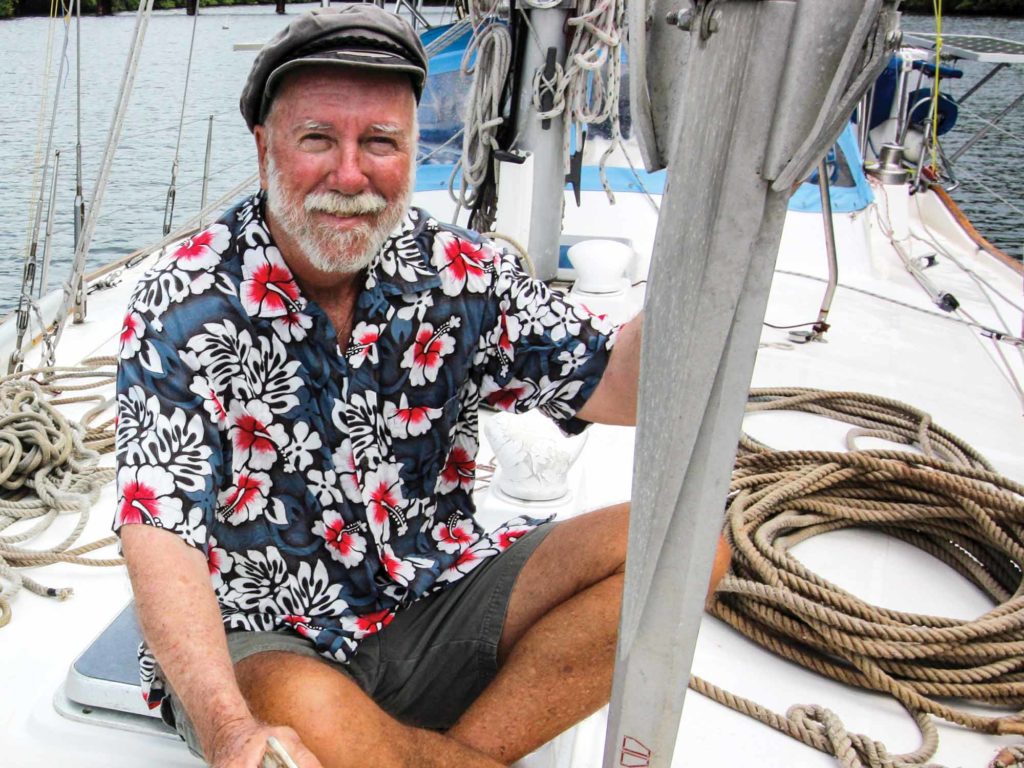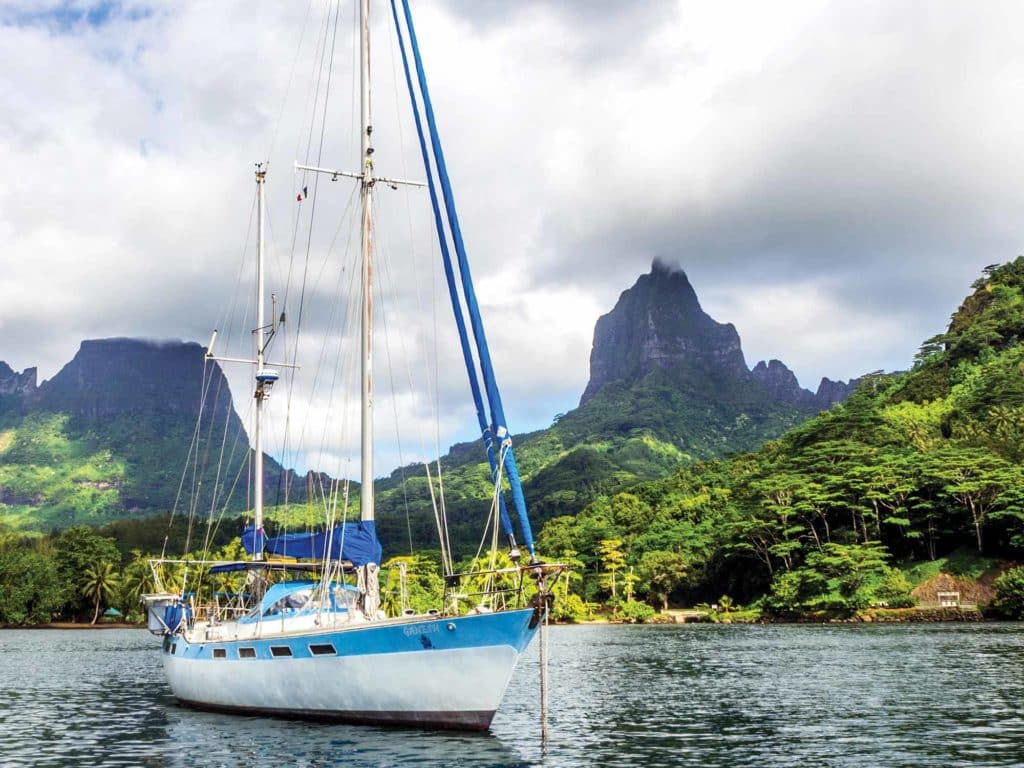
A seasoned skipper and sailboat that has successfully anchored in the Caribbean might not have the gear or expertise to safely anchor in the Pacific. Why? Because the anchorages in the Bahamas and Lesser Antilles are generally benign, with shallow depth, white sand, no swell, few katabatic gusts and zero current. Not so, say, in French Polynesia.
I recently spent a month anchored in Huahine in the Society Islands and was surrounded by dragging sailboats. Anchoring here looks so easy on Google Earth, but it’s extremely challenging in this section of the actual planet Earth. Every single evening, the crews of large vessels (many high-windage single- and double-hulled chartered bareboats) return after a night at the waterfront bars of the main village of Fare to discover that their boat has gone on walkabout. This requires these bewildered crews (if lucky) to find their vessel in the dark, board it in possibly rough conditions, get it underway in treacherous, reef-strewn waters in the pitch-black of night, and then safely reanchor it in a crowded harbor—no easy task.
Why?
The reason is simple: They anchor for the conditions they are currently experiencing, not the conditions they will experience. I repeat: A seasoned sailor realizes that he must anchor to withstand the wind and sea conditions he might get, not the conditions he is currently in.
Conditions change. We know this. These changes must be anticipated.
Is it possible to anchor safely in Huahine? Absolutely! We’ve had no problem (other than people hitting us), and not one fully crewed charter boat manned by a Polynesian skipper (that we know of) has dragged. Does it require unusual or extraordinary gear? No, all that is needed is regular rode and hook—well, a generous amount of chain helps.
Most of the visiting boats arrive from Raiatea or Bora Bora in the afternoon. Afternoons are generally pleasant in July, the season most sailors pass through. Navigation is easy—the white sand jumps out from the deep blue water, and the hundreds of coral heads are easy to spot.
Basically, new arrivals tend to anchor in a millpond and immediately go ashore. This is one of the friendliest isles imaginable. They meet some locals, fall in love, and everyone retires to the Huahine Yacht Club for a wonderful night of local music and food, and laughter.
Alas, every single evening for days on end, we had katabatic wind gusts over 30 knots, and three evenings, the gusts reached 40 knots. Please understand, these are not the winds offshore, which are generally in the 18- to 22-knot range. They are the savage stop-and-go gusts from the high mountains and low valleys of the Haabai area. Of course, any cruising vessel properly anchored should be able to withstand a 30-knot gust. However, a 30-plus-knot gust is much easier to survive from a 20-knot steady breeze versus no wind and then howling. Why? Because your relaxed boat and its chain rode will build up a lot of speed and inertia before it suddenly comes up short. This can, and regularly does, snatch out anchors that have too little scope or too short a snubber.
And all of this takes place inside the lagoon, which, as a child, I thought would offer 360-degree protection; as an adult, I now realize it’s also a 360-degree dead lee shore. Basically, you can’t drag for long off the town anchorage of Fare without hitting another vessel, rock or reef.
But that’s not the whole of it. The moment the wind comes up, the seas build and slop over the windward (east) side of the reef. Each wave contains millions of gallons of water, and all this water has to exit the lagoon somehow and fast. Thus, one’s almost always anchored in some current, and occasionally in more than 4 knots of it.
This means that no vessel in the harbor is lying downwind of its anchor, and some deep-draft monohulls of traditional design can be tide-bound, transom facing into the wind. Centerboarders sometimes lie ahull sideways to the wind. And often catamarans scribe huge circles around their anchors at high rates of speed. (One night we saw a Catana smash into a steel boat, and the sound of the crash almost sickened me.)
Some of the local boats or experienced New Zealanders who regularly cruise these waters have small anti-hunt sails they hoist off their backstay to prevent their vessels from scribing circles when wind and current oppose. We are ketch-rigged on Ganesh, and hoisting our mizzen often either stops this completely or greatly exaggerates it. Given that, we never go ashore with our mizzen sail up in case conditions change.
And, oh, wait—we’re not done. While all the boats anchored off Fare appear to be in a group, they are actually anchored differently. About half are anchored in 8 feet of water, and the other half are anchored in 65 feet of water. Wow!
Now any sailor worth his salt knows the importance of scope: You have to have enough rope or chain deployed to anchor safely. I use a Rocna anchor with 7-to-1 scope when I can, and 5-to-1 when I must. This means that in 65 feet of water, I must deploy 350 feet of chain to safely anchor at the minimum 5-to-1 scope, or 490 feet of chain to anchor with a safety margin of 7-to-1 scope.
That’s a lot of chain. I carry only 225 feet of it, because otherwise my boat goes bow-down and begins to hobbyhorse excessively at sea. True, I have numerous nylon rodes I can add, but this makes retrieving the complicated mess in the middle of the night (say with a 30-foot-wide catamaran jammed on our bow) difficult.
Thus, I avoid anchoring in difficult conditions in 65 feet of water.
I also know that most (but maybe not all) recreational sailing craft anchoring ahead of me in 65 feet of water haven’t planned for 7-to-1 scope or 5-to-1 scope; more likely they’re at 3-to-1 or less, which is totally inadequate for the conditions they will soon face.
Now some Cruising World readers have very sharp pencils and are jumping up and down in protest because my scope numbers are wrong: 65 times 5 isn’t 350, but rather 325! Why am I being so sloppy with the numbers?
I’ll get to that in a second.
My ketch draws 6 feet, and in the lagoon, I was anchored in 8 feet of water, so I deployed 65 feet of chain plus my nylon snubber. Excessive? No, it’s minimal. I should have paid out 91 feet for 7-to-1 scope. Why? Because scope is calculated from the bow roller to the bottom, not by the depth of the water.
Think this doesn’t matter? Think again.
Anchored near us is a centerboard Skipjack-esque vessel (it looks like a Tarpon Springs sponge boat) with a large amount of sheer and a long bowsprit pointing skyward. It’s anchored in only 3 feet of water but requires about the same amount of scope as we do in 8 feet because its side-roller chock is so high above the water on its bowsprit.
There’s another factor: I was anchored on the edge of a sandy shelf, with my anchor well dug into the bottom, in 8 feet, as I said, and eventually with 7-to-1 scope out. So it was almost impossible to anchor ahead of me on this ledge because you couldn’t put out enough scope. Still, two boats anchored in 65 feet of water dragged back toward me until their anchors caught.

This “uphill” anchoring didn’t make me happy because the skippers of these boats couldn’t put out proper scope without hitting me, so they left their rodes as they were, though they were still in deeper water. If the wind reversed, they’d both drag back downhill and then go on walkabout.
In such a situation, what’s my responsibility as a cruiser? Tell them? Don’t tell them? Get in a fistfight or anchorment—er, I mean, argument?
I’ve found, from long experience, that the best thing to do is move. I ignore who is right or who is wrong and who anchored first; I just leave and reanchor my vessel safely. I have no right to tell others how or where to anchor, but I do, most certainly, have an obligation to anchor my boat safely. And that means moving when others anchor improperly around me.
Please don’t misunderstand. I’m not saying to not anchor in Huahine. I recommend you do, because this island is one of the nicest places in French Polynesia. And it is certainly possible because we never dragged, and none of the local skippers do either.
How do you do it?
You need a lot of chain because the Pacific is so much deeper than the Caribbean. I’m often forced to anchor in 80 feet of water in this ocean. Never have I considered such a thing in the Caribbean. (In northern Tonga, I managed to anchor in 105 feet for a month!)
And then you have to anchor far away from others. This usually isn’t a problem, but the fact of the matter is that someone without knowledge of any of the above might anchor right next to you and there’s nothing you can do (save move).
Example: My writer friend Dudley Pope of the Lord Ramage series wanted to finish his novel, so he purchased three spools of nylon line and anchored in more than 100 feet of water off Virgin Gorda. Just as he was tidying up, a Morgan Out Island 41 bareboat dropped its hook right next to him. With a smile, Dudley asked politely, “Do you realize you’re anchoring in over 100 feet of water?”
“No problem,” its not-yet-sunburnt skipper hollered back. “We only draw 4!”
Remember: Anchoring is the bedrock skill of sailors. Once mastered, the world is your oyster. But it can be tricky, especially at night, in Huahine, when the katabatic gusts blow.
Cap’n Fatty and Carolyn Goodlander are sitting out the pandemic aboard their ketch, Ganesh, in Singapore. You can read more about Fatty’s thoughts on dropping the hook in his book Creative Anchoring, available online.








